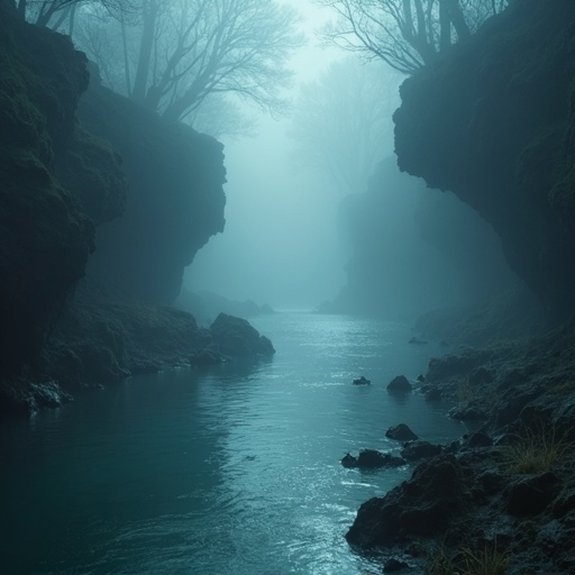The Underworld Rivers: Styx, Lethe, Etc
The ancient Greeks mapped five rivers flowing through the underworld, each serving a distinct purpose in the afterlife’s geography. While Styx and Lethe remain the most recognized, Acheron, Cocytus, and Phlegethon complete this supernatural waterway system. These rivers weren’t merely mythological decorations—they functioned as spiritual barriers and transformative passages that determined souls’ eternal fates. But the earliest texts reveal something unexpected about their true origins.
Introduction

While ancient civilizations once imagined mythical rivers flowing through the domain of the dead, scientists have discovered that genuine underground waterways course through Earth’s hidden depths. These subterranean rivers carve massive channels through limestone and volcanic rock, creating networks that span continents. They’re formed when surface water penetrates permeable rock layers, dissolving minerals and widening natural fractures over millennia.
Unlike their mythological counterparts—the Styx, Lethe, Acheron, and others that Greeks believed separated the living from the dead—real underground rivers sustain ecosystems and supply freshwater to billions. Mexico’s Sistema Sac Actun stretches over 200 miles beneath the Yucatán Peninsula. Vietnam’s Son Doong contains a river that’s sculpted chambers large enough to hold skyscrapers. These hidden waterways shape Earth’s geology and humanity’s survival.
Ancient Greek Literary Sources
When Homer composed the Odyssey in the 8th century BCE, he gave Western literature its first detailed geography of the underworld’s rivers. He described Acheron as the river into which Pyriphlegethon and Cocytus flow, with souls gathering at their confluence. Hesiod’s Theogony expanded this watery landscape, establishing Styx as the gods’ binding oath river.
Later authors enriched these descriptions. Plato’s Republic introduced Lethe‘s memory-erasing waters, while Virgil’s Aeneid synthesized Greek sources for Roman audiences. Aristophanes’ comedies referenced these rivers for dramatic effect, and Pausanias documented local traditions connecting earthly waterways to their underworld counterparts. These texts didn’t always agree—some placed Styx as the boundary, others Acheron—but they collectively built mythology’s most enduring vision of death’s geography.
Notable Cases or Sightings

Modern folklore perpetuates these traditions. Greek locals still point tourists toward supposed entrances to Hades near ancient oracle sites. They’ll describe underground streams that allegedly connect to mythical rivers. Some paranormal investigators claim they’ve recorded unexplained voices near these locations, attributing them to souls crossing Charon’s ferry. While scholars dismiss such accounts as imaginative interpretations of natural phenomena, these stories demonstrate humanity’s enduring fascination with bridging mythological and physical worlds.
Common Theories or Explanations
Although ancient cultures couldn’t explain underground water systems scientifically, they created elaborate mythologies to make sense of these mysterious phenomena. They’ve interpreted subterranean rivers as pathways to the afterlife, believing the earth’s depths naturally connected to divine domains. Greeks theorized that souls needed physical boundaries between worlds, making rivers perfect metaphysical barriers.
Modern scholars suggest these myths reflected real geological features. Ancient peoples encountered caves with flowing water, underground springs, and rivers that disappeared into sinkholes. They’d witness volcanic gases killing animals near certain water sources, reinforcing beliefs about deadly underworld streams. Psychological interpretations propose the rivers represent mental states—Lethe’s forgetfulness mirrors trauma response, while Styx’s invulnerability reflects humanity’s desire to overcome mortality. These explanations show how mythology transformed natural observations into complex spiritual frameworks.
Frequently Asked Questions
How Many Underworld Rivers Exist in Greek Mythology?
Greek mythology features five underworld rivers. They’re the Styx (hatred), Acheron (woe), Cocytus (lamentation), Phlegethon (fire), and Lethe (forgetfulness). Each river serves a specific purpose in the domain of Hades, the Greek underworld.
What Happens if Mortals Drink From These Rivers?
Mortals who drink from Lethe forget everything they’ve known. Styx’s waters grant invulnerability or cause death. Acheron brings sorrow, Cocytus causes lamentation, and Phlegethon’s fiery waters burn. Each river’s effects reflect its mythological purpose.
Can the Dead Cross Back Over These Rivers?
The dead can’t cross back over these rivers once they’ve entered Hades’ domain. Charon won’t ferry souls returning to life, and the rivers themselves form supernatural barriers that trap spirits permanently in the underworld.
Which Gods or Goddesses Guard Each River?
Charon ferries souls across the Styx, while no specific deity guards Lethe. Acheron’s associated with the ferryman Phlegyas, Cocytus doesn’t have a guardian, and Phlegethon’s watched by various underworld spirits rather than one particular god.
Do Other Mythologies Have Similar Underworld Rivers?
Yes, many mythologies feature underworld rivers. Norse mythology has Élivágar’s icy streams. Egyptian mythology includes the celestial Nile in Duat. Hindu tradition describes Vaitarani, which souls must cross. Mesopotamian myths mention the river Hubur.


